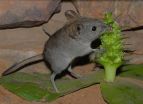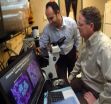(Press-News.org) Washington, D.C. (November 16, 2010) -- In a move that holds great significance for the semiconductor industry, a team of researchers has created an alternative to conventional logic gates, demonstrated them in silicon, and dubbed them "chaogates." The researchers present their findings in Chaos, a journal published by the American Institute of Physics.
Simply put, they used chaotic patterns to encode and manipulate inputs to produce a desired output. They selected desired patterns from the infinite variety offered by a chaotic system. A subset of these patterns was then used to map the system inputs (initial conditions) to their desired outputs. It turns out that this process provides a method to exploit the richness inherent in nonlinear dynamics to design computing devices with the capacity to reconfigure into a range of logic gates. The resulting morphing gates are chaogates.
"Chaogates are the building block of new, chaos-based computer systems that exploit the enormous pattern formation properties of chaotic systems for computation," says William Ditto, an inventor of chaos-based computing and director of the School of Biological Health Systems Engineering at Arizona State University. "Imagine a computer that can change its own internal behavior to create a billion custom chips a second based on what the user is doing that second -- one that can reconfigure itself to be the fastest computer for that moment, for your purpose."
This program is already underway at ChaoLogix, a semiconductor company founded by Ditto and colleagues, headquartered in Gainsville, Florida, into commercial prototypes that could potentially go into every type of consumer electronic device. It has some added advantages for gaming, Ditto explains, as well as for secure computer chips (it is possibly much more immune to hacking of information at the hardware level than conventional computer chips) and custom, morphable gaming chips.
And just as important, integrated circuits using chaogates can be manufactured using the same fabrication, assembly and test facilities as those already in use today. Significantly, these integrated circuits can incorporate standard logic, memory and chaogates on the same device.
###
The article, "Chaogates: morphing logic gates designed to exploit dynamical patterns" by William L. Ditto, A. Miliotis, K. Murali, Sudeshna Sinha, and Mark L. Spano appears in the journal Chaos. See: http://link.aip.org/link/chaoeh/v20/i3/p037107/s1
Journalists may request a free PDF of this article by contacting jbardi@aip.org
ABOUT CHAOS
Chaos is an interdisciplinary journal of non-linear science. The journal is published quarterly by the American Institute of Physics and is devoted to increasing the understanding of nonlinear phenomena and describing the manifestations in a manner comprehensible to researchers from a broad spectrum of disciplines. Special focus issues are published periodically each year and cover topics as diverse as the complex behavior of the human heart to chaotic fluid flow problems. See: http://chaos.aip.org/
ABOUT AIP
The American Institute of Physics is a federation of 10 physical science societies representing more than 135,000 scientists, engineers, and educators and is one of the world's largest publishers of scientific information in the physical sciences. Offering partnership solutions for scientific societies and for similar organizations in science and engineering, AIP is a leader in the field of electronic publishing of scholarly journals. AIP publishes 12 journals (some of which are the most highly cited in their respective fields), two magazines, including its flagship publication Physics Today; and the AIP Conference Proceedings series. Its online publishing platform Scitation hosts nearly two million articles from more than 185 scholarly journals and other publications of 28 learned society publishers.
END
CINCINNATI—Researchers at the University of Cincinnati (UC) have found that fat around the outside of arteries may lead to the development of cardiovascular disease and could be linked to its onset in individuals with diabetes.
David Manka, PhD, a researcher in the division of cardiovascular diseases, and his team found that this fat—known as perivascular adipose tissue—could possibly lead to the formation of fatty buildup inside of arteries and could cause existing buildup to break loose, leading to stroke or heart attack.
These findings are being presented at the ...
The increase in the legal age of sexual consent from 14 to 16 years in 2008 may not be protecting those at greatest risk, according to researchers who have analyzed British Columbia population-based data and recommend additional strategies to safeguard vulnerable children and teens.
In the first study of its kind in Canada, researchers from the University of British Columbia and Simon Fraser University tested the government's reasons for changing the law. Their findings are published in the current issue the Canadian Journal of Human Sexuality.
According to the study's ...
Risø Energy Report 9 lists a wide range of energy technologies in the market with low or no emissions of greenhouse gases, describing how several of these will be made commercially available in the next decades.
However, it is not possible to make the world's energy supply CO2-free as cheaply as possible, using only technology development in the current energy systems. There must be room for technological leaps and there is a need for an integrated process to optimise the entire energy system, from energy production, through transformation into energy carriers, to energy ...
Long-nosed Cape rock elephant-shrews are fond of sticky treats, according to Dr. Petra Wester from the University of Stellenbosch in South Africa. Her investigations show for the first time that the elephant-shrew, Elephantulus edwardii, licks the nectar of the flowers and pollinates the Pagoda lily. Her results are published in Springer's journal, Naturwissenschaften – The Science of Nature.
Dr. Wester studied the behavior of the animals in the northern Cederberg area of South Africa, where Pagoda lily plants, Whiteheadia bifolia (Hyacinthaceae), are found in shady rock ...
CINCINNATI—University of Cincinnati (UC) researchers have discovered a new protein that could be cardioprotective during heart attack, potentially leading to more targeted treatments for patients at risk.
These findings are being presented at the American Heart Association's (AHA) Scientific Sessions in Chicago Nov. 16.
Researchers in the department of pharmacology and cell biophysics, led by Chi Keung Lam, a PhD student, and Wen Zhao, PhD, under the direction of Litsa Kranias, PhD, AHA distinguished scientist and chair of the department, found that HAX-1, an anti-cell ...
For Immediate Release – November 16, 2010 – (Toronto) – A new study from the Centre for Addiction and Mental Health (CAMH) has found that 29,000 Ontario students from grades 7-12 report behaviours indicating that they are gambling problematically. The study also found that more than two-thirds of these students reported problems with substance use and/or alcohol use, and 25% reported a suicide attempt in the past year.
The Ontario Youth Gambling Report looked at self-report data from over 9,000 students across Ontario to monitor trends and areas for concern regarding ...
Dr. Joseph Glavy at Stevens Institute of Technology studies the smallest and most basic elements of life. The Assistant Professor of Chemical Biology runs the Glavy Lab, where advanced student scientists study the nuclear pore complexes (NPCs) in cells, observing the minutest mechanisms of life as they unfold during mitosis. The Glavy Lab's formal purpose is to study the NPC at the molecular level in the pursuit of the unknown or unexpected in the well-studied but not always well-understood nuclei of living cells.
His team has uncovered a disease-related protein outside ...
A new study revealed that the novel self-expanding super-elastic all-metal endoprosthesis stent (SESAME StentTM) used in patients undergoing angioplasty of degenerated saphenous vein graft (SVG) lesions has 100% acute success, low 30 day major adverse cardiac events (MACE) rates, and 9-month patency comparable to balloon expandable stents without embolic protection. Results of the study are published in the November issue of Catheterization and Cardiovascular Intervention, a peer-reviewed journal from The Society for Cardiovascular Angiography and Interventions.
Percutaneous ...
Two essential genes that control the accumulation and detoxification of arsenic in plant cells have been identified. This discovery is the fruit of an international collaboration involving laboratories in Switzerland, South Korea and the United States, with the participation of members of the National Centre of Competence in Research (NCCR) Plant Survival. The results presented are a promising basis for reducing the accumulation of arsenic in crops from regions in Asia that are polluted by this toxic metalloid, as well as for the cleanup of soils contaminated by heavy metals. ...
Scientists are learning more about how protein gets in the urine when the kidneys begin to fail and how a new drug blocks it.
"We have known for a long time that renal failure comes with protein in your urine, especially in diabetes," said Dr. David Pollock, renal physiologist at the Medical College of Georgia Vascular Biology Center. It's also known that a new class of drugs called endothelin A receptor antagonists reduce protein in the urine.
New research published in the journal Hypertension connects the two, providing more information about how new drugs under study ...

